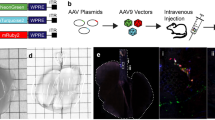Summary
We recorded serotonin-emission intensity using formalin induced fluorescence and counted the number of neuroendocrine cells (NEC's) and neuroepithelial bodies (NEB's) containing argyrophil granules. Comparison of serotonin-emission intensity in NEB's of acutely hypoxic neonates (520 mmHg for 2–21/2 h) and normoxic controls showed significantly lower fluorescence in hypoxic animals. Neuroendocrine cell numbers as shown with Grimelius silver-nitrate stain did not change. This suggests either that the Grimelius stain reacts with compounds other than serotonin, or that the decrease in serotonin in acutely hypoxic rabbits is not sufficient to alter argyrophil stainability.
Similar content being viewed by others
References
Cutz E, Chan W, Wong V, Conen PE (1974) Endocrine cells in rat fetal lungs. Ultrastructural and histochemical study. Lab Invest 30:458–464
Cutz E, Chan W, Wong V, Conen PE (1975) Ultrastructure and fluorescence histochemistry of endocrine (APUD-type) cells in tracheal mucosa of human and various animal species. Cell Tissue Res 158:425–437
Daly I, Hebb C (1966) Pulmonary and bronchial vascular systems. E Arnold Ltd, London
Eaton JA Jr, Fedde MR (1977) Identification of two populations of biogenic amine-containing cells in the mouse lung. Cell Tissue Res 175:243–249
Feyrter F (1938) Über diffuse endokrine epitheliale Organe. J A Barth, Leipzig
Fröhlich F (1949) Die “helle Zelle” der Bronchialschleimhaut und ihre Beziehungen zum Problem der Chemoreceptoren. Frankfurt, Z Pathol 60:517–559
Grimelius L (1968) A silver nitrate stain for α2 cells in human pancreatic islets. Acta Societatis Medicorum Upsaliensis 73:243–270
Hage E (1973) Amine-handling properties of APUD-cells in the bronchial epithelium of human foetuses in the epithelium of the main bronchi of human adults. Acta Pathol Scand Sect A 81:64–70
Hage E, Hage J, Juel G (1977) Endocrine-like cells of the pulmonary epithelium of the human adult lung. Cell Tissue Res 178:39–48
Hernandez-Vasquez A, Will JA, Quay WB (1977) Quantitative characteristics of the Feyrter (APUD) cells of the neonatal rabbit lung in normoxia and chronic hypoxia. Thorax 32:449–456
Hernandez-Vasquez A, Will JA, Quay WB (1978) Quantitative characteristics of the Feyrter cells and neuroepithelial bodies of the fetal rabbit lung in normoxia and short term chronic hypoxia. Cell Tissue Res 189:179–186
Keith I, Wiley L, Will J (1980) Standardization of formalin induced fluorescence and its measurement to quantify serotonin emission. (Submitted for publication)
Laros CD (1971) Local chemical regulation of the flow resistance in the bronchial tree and pulmonary circulation. Respiration 28:120–136
Lauweryns JM, Peuskens J (1972) Neuroepithelial bodies (neuroreceptor or secretory organs) in human infant bronchial and bronchiolar epithelium. Anat Res 172:471–482
Lauweryns JM, Cokelaere M (1973a) Intrapulmonary neuro-epithelial bodies: hypoxia-sensitive neuro (chemo-) receptors. Experientia 29:1384–1386
Lauweryns JM, Cokelaere M, Theunynck P (1973b) Serotonin producing neuroepithelial bodies in rabbit respiratory mucosa. Science 180:410–413
Lauweryns JM, Cokelaere M, Theunynck D, Deelersnyder M (1974a) Neuroepithelial bodies in mammalian respiratory mucosa. Light optical, histochemical and ultrastructural studies. Chest 65 Suppl, 225–295
Lauweryns JM, Goddeeris P (1974b) Neuroepithelial bodies in the human child and adult lung. Am Rev Resp Dis 111:469–476
Lauweryns JM, Cokelaere M, Deelersnyder M (1977a) Intrapulmonary neuroepithelial bodies in newborn rabbits. Influence of hypoxia, hyperoxia, hypercapnia, nicotine, reserpine, L-DOPA, and 5-HTP. Cell Tissue Res 182:425–140
Lauweryns JM, Liebens M (1977b) Microspectrography of formaldehyde and fluorescamine-induced fluorescence in rabbit pulmonary neuro-epithelial bodies: Demonstration of a new, probably polypeptide intracytoplasmic substance. Experientia 33:1510–1511
Moosavi H, Smith P, Heath D (1973) The Feyrter cell in hypoxia. Thorax 28:729–741
Pearse AGE (1969) The cytochemistry and ultrastructure of polypeptide hormone-producing cells of the APUD series and the embryologic, physiologic, and pathologic implications of the concept. J Histochem Cytochem 17:303–313
Polak JM, Bloom SR, Wharton J, Ghatei M, Brown M, Will JA (1978) Bombesin — a new lung peptide. Fed Proc 37:807
Sonstegard K, Wong V, Cutz E (1979) Neuro-epithelial bodies in organ cultures of fetal rabbit lungs. Ultrastructural characteristics and effects of drugs. Cell Tissue Res 199:159–170
Tateishi R (1973) Distribution of argyrophil cells in adult human lungs. Arch Pathol 96:198–202
Taylor W (1977) Pulmonary argyrophil cells at high altitude. J Pathol 122:137–144
Ungerer T (1975) The acute responses of the pulmonary circulation of the unanaesthetized pig to sympathominetic amines. Thesis Dept Vet Sci, Univ WI, Madison WI 53706 USA
Wharton J, Polak JM, Bloom SR, Ghatei MA, Solcia E, Brown BR, Pearse AGE (1978) Bombesin-like immunoreactivity in the lung. Nature 273:769–770
Author information
Authors and Affiliations
Additional information
Supported by the College of Agricultural and Life Sciences, University of Wisconsin-Madison and a grant from The Council for Tobacco Research, Inc. USA Number 1036
We are grateful to Ms. Sharon DeFoliart and Ms. Maureen Decorah for technical assistance. We also thank Dr. Walter Flaut who kindly let us use the fluorescence microscope, and contributed helpful advice. The use of the hypobaric chamber at the Biotron, University of Wisconsin-Madison, was essential for the study
Rights and permissions
About this article
Cite this article
Keith, I.M., Wiley, L.A. & Will, J.A. Pulmonary neuroendocrine cells: Decreased serotonin fluorescence and stable argyrophil-cell numbers in acute hypoxia. Cell Tissue Res. 214, 201–205 (1981). https://doi.org/10.1007/BF00235157
Accepted:
Issue Date:
DOI: https://doi.org/10.1007/BF00235157




